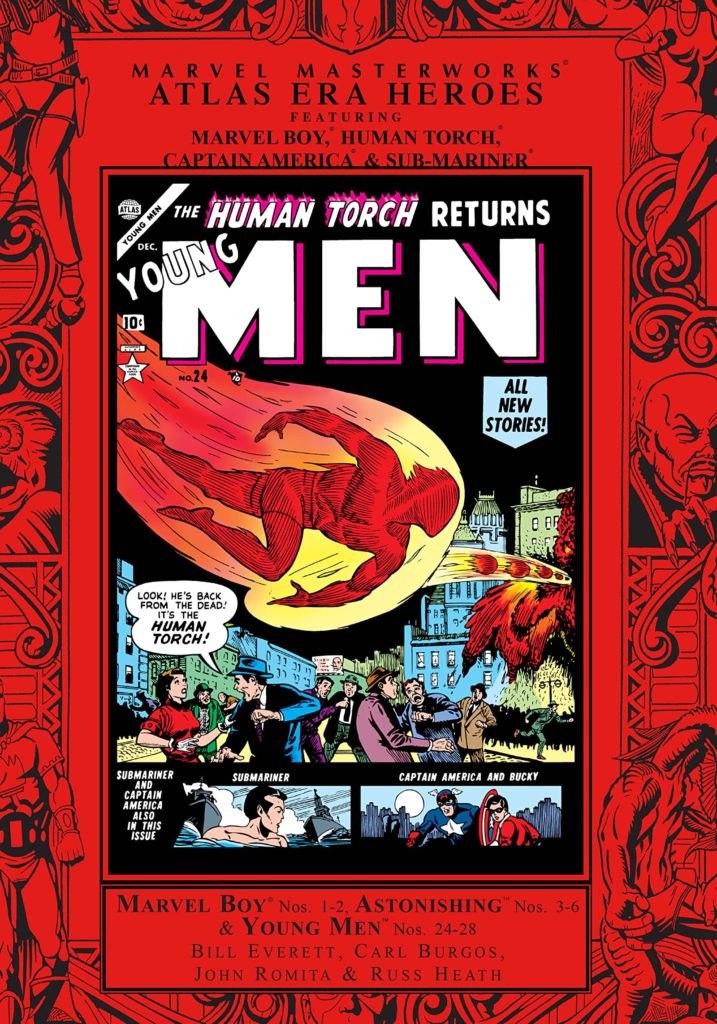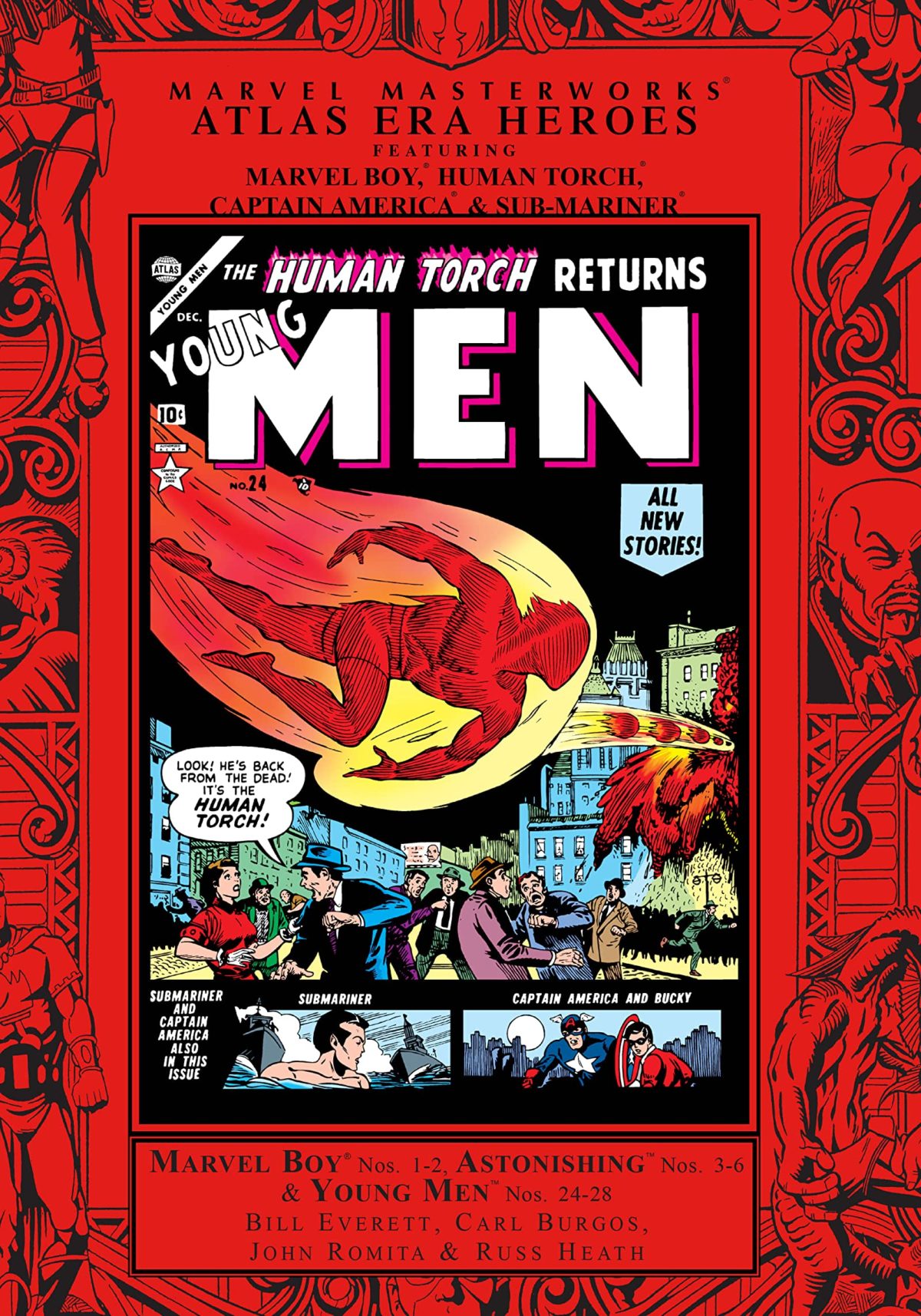Comic Book Review: Marvel Masterworks: Atlas Era Heroes 1 edited by Cory Sedlmeier
As has been mentioned on this blog before, by the late 1940s, superheroes had become passe in comic books. A handful continued to be published over at National Publications (DC) on a regular basis, and there was the odd minor publisher title, but other genres had taken over the field. Timely/Marvel/soon to be Atlas ceased publication of its “Big Three” (Captain America, Namor and the Human Torch) in 1949. But publisher Martin Goodman had a brainstorm….

There was a flying saucers craze going on, and Mr. Goodman thought a science fiction-flavored superhero would go down a treat. Thus, Marvel Boy was created in 1950. As explained in the first issue, Professor Matthew Grayson’s wife was murdered by the Nazis in 1934. Realizing that Europe was headed for a great war, and that his atomic research would be abused by whichever government seized it, Professor Grayson built a rocketship to take him and his toddler son Bob to the Moon to live. The ship was thrown off course, and landed on the utopian planet of Uranus. (You should just get all the “your anus” jokes out of your system right now.)
Uranus’ lower gravity gave Bob superior strength, and their advanced peaceful civilization trained him to physical and mental perfection. He even learned a limited (and inconsistently written) form of telepathy! But now that he’s grown, and the Earth humans have discovered atomic power on their own, Bob wants to visit his home world and help them out. Professor Grayson gives Bob a new outfit, uranium pills that will energize Bob’s body and negate the effects of Earth’s higher gravity, and a light-jewel that produces a bright light to blind enemies so that Bob will not have to resort to killing.
Back on Earth, a new “continent” has risen in the South Atlantic. (The scale of events make it more likely to be just a large island.) As it happens, just one ship was in the area, and is now beached on the new continent. That ship is run by the modern-day pirate “Count” Varron. His family was expelled from Bosnia shortly before it was absorbed into Yugoslavia, making him a stateless refugee, and none of the successor states nor any other nation have granted him citizenship. Therefore, he is a man without a country, and under maritime law as the discoverer of this new land owns it and any resources it may possess.
Except that there turn out to be natives, the people who were living here when the continent sank beneath the waves in the 8th Century, and have adapted to underwater life. And under the new international laws, they own the land and you’re not allowed to just take over. But there’s a loophole in the law that will still allow the founding of Varronland. If all the natives are dead before anyone else arrives, Count Varron will own the land free and clear!
But Marvel Boy has arrived on Earth, and he will not stand for this aggression. He’s not keen on the natives killing the criminals, either. However, in the end Varron destroys himself and the continent resinks.
A fair enough beginning. In subsequent stories, Marvel Boy fights a supervillain, an alien invasion, and Communist agents. But even as the first issue of Marvel Boy was being produced, Mr. Goodman decided that science fiction wasn’t the next big thing, horror was. So the title changed to Astonishing with issue #3 and there was a narrative shift towards scary stuff.
The most blatantly horror story was “The Screaming Tombs” in which Marvel Boy fights the anthropomorphic manifestation of Death itself, but other stories had horrific setups explained by science fiction. We also learned that Uranian society was not as Utopian as previously depicted in a story that’s clearly pre-Code as the entire police force is revealed to be corrupt, with only Bob’s independent Youth Patrol remaining clean.
There are back-up stories as well, the most interesting of which is “The Nightmare” written by Hank Chapman with art by Wayne Boring. It’s about a horror comic writer who gets his inspiration from his nightmares. At one point he talks to his editor, creating (so far as I know) the first Stan Lee cameo.
From #7 on, Astonishing became a straight-up horror anthology. Marvel Boy vanished until the late 1960s when Roy Thomas (who wrote the introduction to this volume) brought him back as the Crusader to fight the Fantastic Four and die. He’s since returned in Agents of Atlas.
Bill Everett did most of the art for the series, giving Bob a smug or even slightly sinister appearance in many scenes.
Interestingly, there’s absolutely no secret identity nonsense. Bob Grayson, reporter, insurance investigator and sometimes circus aerialist, never pretends that he isn’t also the superhero Marvel Boy, it’s just that most people don’t connect the two names until he mentions this fact.
In 1953, Mr. Goodman decided the time was right for another try at superheroes. The Adventures of Superman was doing very well on television, so why not cash in? Young Men, previously a comic book about hot rods (after having been several other things) became a superhero comic for issues #24-28. Each issue had three short stories starring the Human Torch and Toro, Captain America and Bucky, and Namor the Sub-Mariner. The Human Torch got all the covers, presumably because a guy who’s on fire is the best visual.
Each of the first issue stories explained why we hadn’t heard from the characters in a while. The Human Torch (actually an android) had had his powers neutralized and was in an airless casket in the desert until nuclear testing breached the container. Steve Rogers, who had been given a super-serum that gave him peak human performance, had retired to become a school teacher and only a fan who wanted to be the new Bucky knew the connection. Captain America only came out of retirement to fight the Communist menace as exemplified by former Nazi Red Skull. And Namor (whose origins I discussed in my review of Essential Sub-Mariner) had gone home to Atlantis, until his old squeeze Betty Dean asks him to look into a series of shipwrecks in the Pacific Ocean.
Per Mr. Thomas’ introduction, most of the people who worked on this brief revival retained very little memory of it, with Stan Lee in particular not even remembering it ever happened unless specifically reminded. Which is not to say these aren’t fun stories. Three in particular stand out to me.
“The Return of…the Human Torch” by Carl Burgos has him and Toro investigating a wave of crime by young men who laugh at the thought of being put behind bars. At the same time, every male senior citizen has vanished from the city’s nursing homes and care facilities! These two things are of course related. Toro’s only known living relative dies.
An untitled Sub-Mariner story by Bill Everett has him investigating a series of shark attacks and disappearances that don’t seem to be shark attacks off the coast of New York, decades before Peter Benchley wrote Jaws. Turns out it’s a race of man-eating shark people…sort of. Very nice art on the shark people.
“Captain America Turns Traitor!” by John Romita is notable for a cameo by both the Human Torch and Namor in the same panel with Cap, the first time since the second and final issue of All-Winners’ Squad. The story itself involves a Red spy attempting to inject Captain America with a “virus of evil” that will turn him into a Communist. It seems to work, with Cap now talking about how there are “good people on both sides” and being willing to visit the Soviet Union as a guest. Bucky is increasingly worried until it turns out Cap was never brainwashed at all.
The revival went on in other titles for about a year, but that’s in the next volume.
While this period isn’t entirely about fighting Communism, it’s clear that editor/writer/plotter Stan Lee went to Reds as stock villains much more than the folks over at DC did.
When the big superhero boom for Marvel happened in the 1960s, the Human Torch was replaced by an entirely new character, Johnny Storm of the Fantastic Four. Eventually, retcons came in explaining what had happened to make the Jim Hammond version of the character no longer exist, but newer retcons have now made him alive again. Whether any of his 1950s stories happened is kind of up in the air.
The FF’s comic book also brought back Namor, who’d been amnesiac for “some years” and living in a flophouse as a derelict. Again, the status of the Fifties stories is not clear.
Less lucky was the 1950s version of Captain America, who was retroactively turned into an impostor who’d eventually succumbed to paranoia induced by the flawed supersoldier serum he’d used to duplicate the real Steve Rogers’ abilities. “Crazy Fifties Cap” has since shown up a few times as a villain who is a dark mirror of “real Captain America.” Communist Red Skull was also “revealed” to be an impostor and killed off by the returned Nazi Skull, but not before he turned out to have murdered Peter Parker’s birth parents.
Content note: A fraudulent psychic pretends to be a Muslim and uses a lot of phrases and quotes to make himself sound like a follower of Islam, but no mention is made of how he’s violating the religion’s rules.
This is an important volume for scholars of Marvel’s superhero history, and has fun stories for more casual fans. It’s spendy, so you will probably want to check it out from your local library first to see if you want to invest in a permanent copy.

